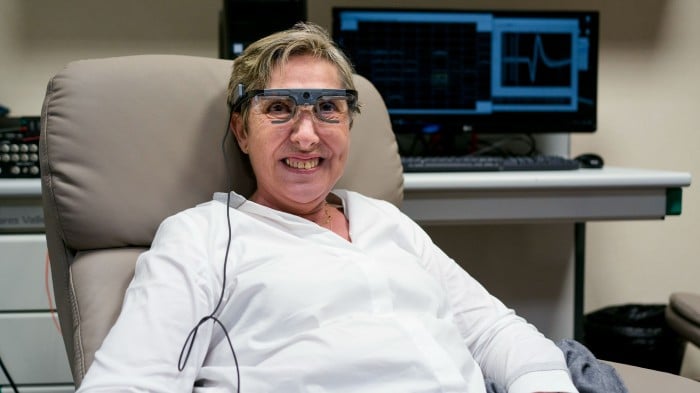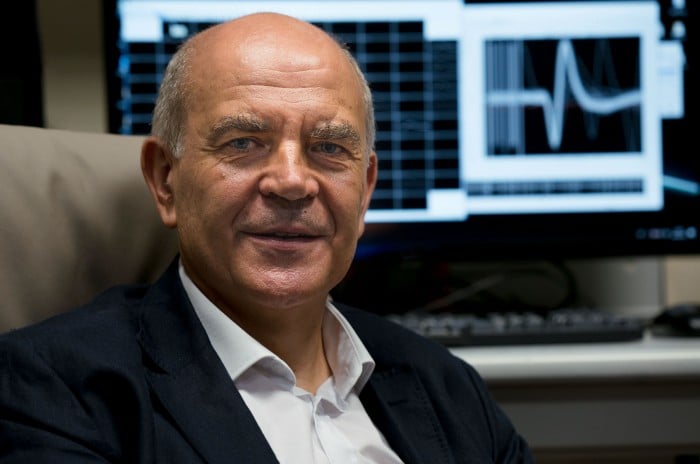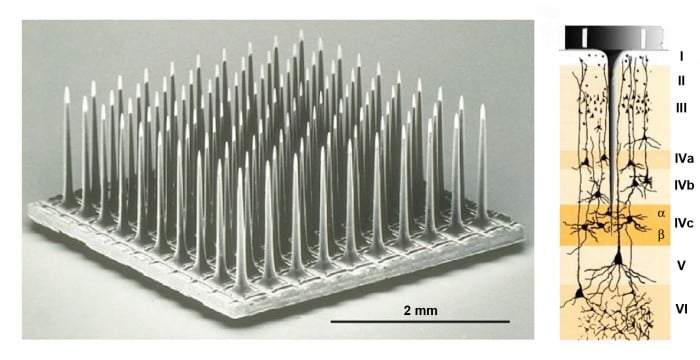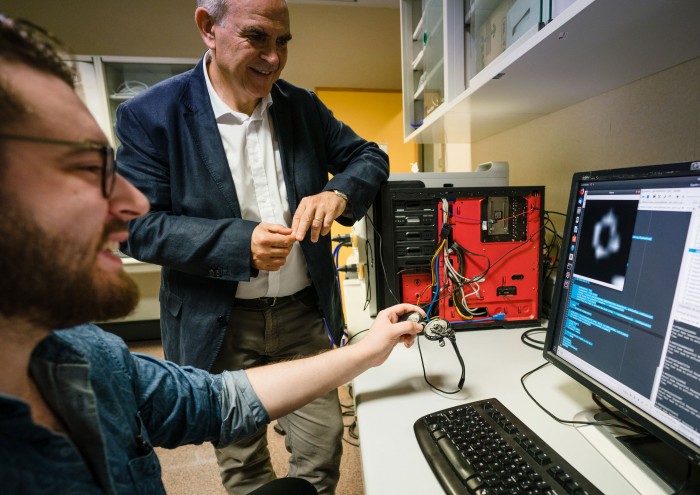Is There a Way Blind People Can See Again
"Allí," says Bernardeta Gómez in her native Spanish, pointing to a big black line running across a white sheet of cardboard propped at arm'southward length in front of her. "At that place."
Information technology isn't exactly an impressive feat for a 57-yr-old woman—except that Gómez is blind. And she'due south been that fashion for over a decade. When she was 42, toxic optic neuropathy destroyed the bundles of fretfulness that connect Gómez'southward eyes to her encephalon, rendering her totally without sight. She's unable even to detect light.
But afterwards 16 years of darkness, Gómez was given a half dozen-month window during which she could meet a very depression-resolution semblance of the earth represented by glowing white-xanthous dots and shapes. This was possible cheers to a modified pair of glasses, blacked out and fitted with a tiny camera. The contraption is hooked up to a calculator that processes a live video feed, turning it into electronic signals. A cable suspended from the ceiling links the organization to a port embedded in the back of Gómez's skull that is wired to a 100-electrode implant in the visual cortex in the rear of her brain.

Russ Juskalian
Using this, Gómez identified ceiling lights, letters, basic shapes printed on paper, and people. She even played a simple Pac-Man–similar figurer game piped directly into her brain. Four days a week for the duration of the experiment, Gómez was led to a lab by her sighted husband and hooked into the system.
Gómez's beginning moment of sight, at the stop of 2018, was the culmination of decades of research past Eduardo Fernandez, managing director of neuroengineering at the University of Miguel Hernandez, in Elche, Espana. His goal: to render sight to as many as possible of the 36 million bullheaded people worldwide who wish to run into again. Fernandez's arroyo is particularly heady because it bypasses the eye and optical nerves.
Much earlier enquiry attempted to restore vision past creating an bogus eye or retina. It worked, but the vast majority of blind people, similar Gómez, have harm to the nerve system connecting the retina to the dorsum of the encephalon. An artificial eye won't solve their incomprehension. That's why in 2015, the company Second Sight, which received approval to sell an artificial retina in Europe in 2011—and in the Usa in 2013—for a rare disease called retinitis pigmentosa, switched two decades of work away from the retina to the cortex. (Second Sight says slightly more than 350 people are using its Argus Ii retinal implant.)
During a recent visit I made to palm-studded Elche, Fernandez told me that advances in implant technology, and a more refined understanding of the homo visual system, accept given him the confidence to get directly to the brain. "The information in the nervous organisation is the same information that'southward in an electric device," he says
Restoring sight by feeding signals straight to the brain is ambitious. But the underlying principles have been used in human-electronic implants in mainstream medicine for decades. "Right at present," Fernandez explains, "nosotros have many electric devices interacting with the human torso. 1 of them is the pacemaker. And in the sensory system we take the cochlear implant."

Russ Juskalian
This latter device is the hearing version of the prosthesis Fernandez built for Gómez: an external microphone and processing system that transmits a digital signal to an implant in the inner ear. The implant's electrodes ship pulses of electric current into nearby nerves that the brain interprets every bit sound. The cochlear implant, which was first installed in a patient in 1961, lets over half a million people around the earth take conversations as a normal part of everyday life.
"Berna was our beginning patient, but over the next couple of years nosotros will install implants in five more than blind people," says Fernandez, who calls Gómez by her first name. "We had done similar experiments in animals, but a cat or a monkey tin't explain what information technology's seeing."
Berna could.
Her experiment took backbone. It required brain surgery on an otherwise good for you torso—always a risky process—to install the implant. So once more to remove it six months later, since the prosthesis isn't approved for longer-term use.
Seizures and phosphenes
I hear Gómez before I see her. Hers is the voice of a woman about a decade younger than her age. Her words are measured, her cadence is perfectly shine, and her tone is warm, confident, and steady.
When I finally see her in the lab, I notice Gómez knows the layout of the infinite so well she barely needs assist navigating the small-scale hallway and its attached rooms. When I walk over to greet her, Gómez's face is initially pointing in the wrong direction until I say hi. When I reach out to milk shake her mitt, her husband guides her hand into mine.
Gómez is here for a encephalon MRI to meet how things look one-half a yr afterwards having her implant removed (they look skillful). She's as well here to meet a potential 2nd patient who is in town, and in the room during my visit. At one indicate during this coming together, as Fernandez explains how the hardware connects to the skull, Gómez interrupts the discussion, tilts forward, and places the prospect's hand on the back of her caput, where a metal outlet used to be. Today in that location'southward virtually no evidence of the port. The implant surgery was so uneventful, she says, that she came to the lab the very next day to get plugged in and outset the experiments. She'southward had no issues or pain since.
Gómez was lucky. The long history of experiments leading to her successful implant has a checkered by. In 1929, a German neurologist named Otfrid Foerster discovered that he could elicit a white dot in the vision of a patient if he stuck an electrode into the visual cortex of the brain while doing surgery. He dubbed the phenomenon a phosphene. Scientists and sci-fi authors take since imagined the potential for a camera-to-figurer-to-brain visual prosthesis. Some researchers even built rudimentary systems.
In the early 2000s, the hypothetical became a reality when an eccentric biomedical researcher named William Dobelle installed such a prosthesis in the caput of an experimental patient.
In 2002, the writer Steven Kotler recalled with horror watching Dobelle creepo upwards the electricity and a patient fall to the floor writhing in a seizure. The crusade was as well much stimulation with too much current—something, it turns out, brains don't like. Dobelle's patients also had problems with infections. Yet Dobelle marketed his beefy device as nearly ready for day-to-day use, complete with a promotional video of a blind man driving slowly and unsteadily in a closed parking lot. When Dobelle died in 2004, so did his prosthesis.
Dissimilar Dobelle, who proclaimed a cure for the blind, Fernandez most constantly says things like, "I don't want to get whatsoever hopes up," and "Nosotros hope to have a arrangement people tin use, but right at present we're merely conducting early on experiments."
But Gómez did in fact see.
Bed of nails
If the basic thought behind Gómez's sight—plug a photographic camera into a video cablevision into the brain—is unproblematic, the details are non. Fernandez and his team first had to effigy out the camera function. What kind of signal does a human retina produce? To endeavour to respond this question, Fernandez takes human retinas from people who have recently died, hooks the retinas up to electrodes, exposes them to light, and measures what hits the electrodes. (His lab has a close relationship with the local infirmary, which sometimes calls in the eye of the night when an organ donor dies. A man retina can be kept alive for only about 7 hours.) His team likewise uses automobile learning to match the retina'due south electric output to uncomplicated visual inputs, which helps them write software to mimic the process automatically.
The next step is taking this signal and delivering information technology to the brain. In the prosthesis Fernandez built for Gómez, a cabled connectedness runs to a common neuro-implant known as a Utah array, which is but smaller than the raised tip on the positive finish of a AAA battery. Protruding from the implant are 100 tiny electrode spikes, each about a millimeter alpine—together they look like a miniature bed of nails. Each electrode can evangelize a current to betwixt ane and four neurons. When the implant is inserted, the electrodes pierce the surface of the encephalon; when it's removed, 100 tiny droplets of blood form in the holes.

Fernandez
Fernandez had to calibrate one electrode at a time, sending it increasingly potent currents until Gómez noted when and where she saw a phosphene. Getting all 100 electrodes dialed in took more than a month.
"The advantage to our approach is that the array's electrodes protrude into the brain and sit close to the neurons," Fernandez says. This lets the implant produce sight with a much lower electrical current than was needed in Dobelle's organisation, which sharply reduces the risk of seizures.
The big downside to the prosthesis—and the chief reason Gómez couldn't go on hers beyond six months—is that nobody knows how long the electrodes tin concluding without degrading either the implant or the user's encephalon. "The trunk's immune system starts to interruption downwards the electrodes and surround them with scar tissue, which eventually weakens the point," Fernandez says. There's also the problem of the electrodes flexing as someone moves around. Judging from inquiry in animals and an early on look at the array Gómez used, he supposes the current setup could last two to three years, and maybe upwardly to 10 earlier information technology fails. Fernandez hopes a few minor tweaks will extend that to a few decades—a critical prerequisite for a slice of medical hardware that requires invasive brain surgery.
Eventually, the prosthesis, like a cochlear implant, will demand to transmit its signal and power wirelessly through the skull to reach the electrodes. Simply for at present, his squad has so far left the prosthesis cabled for experiments—providing the nigh flexibility to go on updating the hardware earlier settling on a design.
At 10 pixels by ten pixels, which is roughly the maximum potential resolution Gómez's implant could render, one may perceive basic shapes like letters, a door frame, or a sidewalk. Just the contours of a face up, let alone a person, are far more complicated. That's why Fernandez augmented his arrangement with epitome recognition software to identify a person in a room and beam a pattern of phosphenes to Gómez's brain that she learned to recognize.
At 25 by 25 pixels, Fernandez writes in a slide he likes to present, "vision is possible." And considering the Utah array in its electric current class is so pocket-sized and requires so little power to run, Fernandez says at that place'south no technical reason his team couldn't install four to six on each side of the brain, offering vision at 60 x 60 pixels or higher. Still, nobody knows how much input the human brain tin can take from such devices without beingness overwhelmed and displaying the equivalent of Television set snow.
What information technology looks similar

Russ Juskalian
Gómez told me she would accept kept the implant installed if she had been given the pick and that she'll be first in line if an updated version is available. When Fernandez is done analyzing her array, Gómez plans to have it framed and hang it on her living room wall.
Back in Fernandez'due south lab, he offers to claw me up to a noninvasive device he uses to screen patients.
Sitting in the same leather chair Gómez occupied during last year's breakthrough experiment, I wait as a neurologist holds a wand with two rings against the side of my head. The device, called a butterfly curlicue, is connected to a box that excites neurons in the encephalon with a powerful electromagnetic pulse—a phenomenon called transcranial magnetic stimulation. The get-go blast feels as if someone is shocking my scalp. My fingers involuntarily curl into my palms. "Look, it worked!" Fernandez says, chuckling. "That was your motor cortex. Now we volition try to give you some phosphenes."
The neurologist repositions the wand and sets the auto for a rapid series of pulses. This fourth dimension when she fires, I feel an intense zzp-zzp-zzp, as if someone were using the dorsum of my skull as a door knocker. Then, even though my optics are wide open, I see something: a brilliant horizontal line flashes across the center of my field of vision, along with two shimmering triangles filled with what looks like Television receiver snow. The vision fades as rapidly every bit it arrived, leaving a brief afterglow.
"This is similar what Berna could see," Fernandez says. Except her "sight" of the world was stable as long as the signal was being transmitted to her brain. She could also turn her head and, with her spectacles on, look effectually the room. What I had seen were but internal phantoms of an electrically excited brain. Gómez could really reach out and impact the earth she was looking at for the first time in 16 years.
Source: https://www.technologyreview.com/2020/02/06/844908/a-new-implant-for-blind-people-jacks-directly-into-the-brain/
0 Response to "Is There a Way Blind People Can See Again"
Postar um comentário